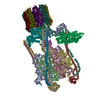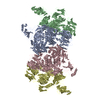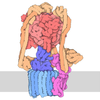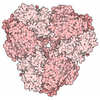+ データを開く
データを開く
- 基本情報
基本情報
| 登録情報 | データベース: PDB / ID: 3j9t | ||||||
|---|---|---|---|---|---|---|---|
| タイトル | Yeast V-ATPase state 1 | ||||||
 要素 要素 |
| ||||||
 キーワード キーワード | HYDROLASE / V-ATPase / V-type ATPase / vacuolar-type ATPase / proton pump | ||||||
| 機能・相同性 |  機能・相同性情報 機能・相同性情報vacuole-mitochondrion membrane contact site / protein localization to vacuolar membrane / cellular response to alkaline pH / Insulin receptor recycling / Transferrin endocytosis and recycling / polyphosphate metabolic process / ROS and RNS production in phagocytes / Amino acids regulate mTORC1 / Golgi lumen acidification / proteasome storage granule assembly ...vacuole-mitochondrion membrane contact site / protein localization to vacuolar membrane / cellular response to alkaline pH / Insulin receptor recycling / Transferrin endocytosis and recycling / polyphosphate metabolic process / ROS and RNS production in phagocytes / Amino acids regulate mTORC1 / Golgi lumen acidification / proteasome storage granule assembly / vacuolar proton-transporting V-type ATPase, V1 domain / vacuolar transport / vacuolar proton-transporting V-type ATPase, V0 domain / endosomal lumen acidification / vacuole organization / protein targeting to vacuole / proton-transporting V-type ATPase complex / pexophagy / intron homing / intein-mediated protein splicing / fungal-type vacuole / vacuolar proton-transporting V-type ATPase complex / cellular hyperosmotic response / vacuolar acidification / fungal-type vacuole membrane / phosphatidylinositol-3,5-bisphosphate binding / proton transmembrane transporter activity / proton-transporting ATPase activity, rotational mechanism / intracellular copper ion homeostasis / H+-transporting two-sector ATPase / ATP metabolic process / Neutrophil degranulation / proton transmembrane transport / transmembrane transport / endocytosis / intracellular calcium ion homeostasis / cytoplasmic stress granule / ATPase binding / protein-containing complex assembly / endonuclease activity / 加水分解酵素; エステル加水分解酵素 / intracellular iron ion homeostasis / membrane raft / Golgi membrane / mRNA binding / ATP hydrolysis activity / DNA binding / ATP binding / membrane / cytoplasm 類似検索 - 分子機能 | ||||||
| 生物種 |  | ||||||
| 手法 | 電子顕微鏡法 / 単粒子再構成法 / クライオ電子顕微鏡法 / 解像度: 6.9 Å | ||||||
 データ登録者 データ登録者 | Zhao, J. / Benlekbir, S. / Rubinstein, J.L. | ||||||
 引用 引用 |  ジャーナル: Nature / 年: 2015 ジャーナル: Nature / 年: 2015タイトル: Electron cryomicroscopy observation of rotational states in a eukaryotic V-ATPase. 著者: Jianhua Zhao / Samir Benlekbir / John L Rubinstein /  要旨: Eukaryotic vacuolar H(+)-ATPases (V-ATPases) are rotary enzymes that use energy from hydrolysis of ATP to ADP to pump protons across membranes and control the pH of many intracellular compartments. ...Eukaryotic vacuolar H(+)-ATPases (V-ATPases) are rotary enzymes that use energy from hydrolysis of ATP to ADP to pump protons across membranes and control the pH of many intracellular compartments. ATP hydrolysis in the soluble catalytic region of the enzyme is coupled to proton translocation through the membrane-bound region by rotation of a central rotor subcomplex, with peripheral stalks preventing the entire membrane-bound region from turning with the rotor. The eukaryotic V-ATPase is the most complex rotary ATPase: it has three peripheral stalks, a hetero-oligomeric proton-conducting proteolipid ring, several subunits not found in other rotary ATPases, and is regulated by reversible dissociation of its catalytic and proton-conducting regions. Studies of ATP synthases, V-ATPases, and bacterial/archaeal V/A-ATPases have suggested that flexibility is necessary for the catalytic mechanism of rotary ATPases, but the structures of different rotational states have never been observed experimentally. Here we use electron cryomicroscopy to obtain structures for three rotational states of the V-ATPase from the yeast Saccharomyces cerevisiae. The resulting series of structures shows ten proteolipid subunits in the c-ring, setting the ATP:H(+) ratio for proton pumping by the V-ATPase at 3:10, and reveals long and highly tilted transmembrane α-helices in the a-subunit that interact with the c-ring. The three different maps reveal the conformational changes that occur to couple rotation in the symmetry-mismatched soluble catalytic region to the membrane-bound proton-translocating region. Almost all of the subunits of the enzyme undergo conformational changes during the transitions between these three rotational states. The structures of these states provide direct evidence that deformation during rotation enables the smooth transmission of power through rotary ATPases. | ||||||
| 履歴 |
|
- 構造の表示
構造の表示
| ムービー |
 ムービービューア ムービービューア |
|---|---|
| 構造ビューア | 分子:  Molmil Molmil Jmol/JSmol Jmol/JSmol |
- ダウンロードとリンク
ダウンロードとリンク
- ダウンロード
ダウンロード
| PDBx/mmCIF形式 |  3j9t.cif.gz 3j9t.cif.gz | 1.2 MB | 表示 |  PDBx/mmCIF形式 PDBx/mmCIF形式 |
|---|---|---|---|---|
| PDB形式 |  pdb3j9t.ent.gz pdb3j9t.ent.gz | 976.7 KB | 表示 |  PDB形式 PDB形式 |
| PDBx/mmJSON形式 |  3j9t.json.gz 3j9t.json.gz | ツリー表示 |  PDBx/mmJSON形式 PDBx/mmJSON形式 | |
| その他 |  その他のダウンロード その他のダウンロード |
-検証レポート
| 文書・要旨 |  3j9t_validation.pdf.gz 3j9t_validation.pdf.gz | 1.1 MB | 表示 |  wwPDB検証レポート wwPDB検証レポート |
|---|---|---|---|---|
| 文書・詳細版 |  3j9t_full_validation.pdf.gz 3j9t_full_validation.pdf.gz | 1.4 MB | 表示 | |
| XML形式データ |  3j9t_validation.xml.gz 3j9t_validation.xml.gz | 202.7 KB | 表示 | |
| CIF形式データ |  3j9t_validation.cif.gz 3j9t_validation.cif.gz | 308.8 KB | 表示 | |
| アーカイブディレクトリ |  https://data.pdbj.org/pub/pdb/validation_reports/j9/3j9t https://data.pdbj.org/pub/pdb/validation_reports/j9/3j9t ftp://data.pdbj.org/pub/pdb/validation_reports/j9/3j9t ftp://data.pdbj.org/pub/pdb/validation_reports/j9/3j9t | HTTPS FTP |
-関連構造データ
- リンク
リンク
- 集合体
集合体
| 登録構造単位 | 
|
|---|---|
| 1 |
|
- 要素
要素
-V-type proton ATPase subunit ... , 10種, 25分子 MNBDFQLHJKGIPbOYRUVTWSXZa
| #1: タンパク質 | 分子量: 29235.023 Da / 分子数: 1 / 由来タイプ: 天然 / 由来: (天然)  | ||||||||||||||
|---|---|---|---|---|---|---|---|---|---|---|---|---|---|---|---|
| #2: タンパク質 | 分子量: 13479.170 Da / 分子数: 1 / 由来タイプ: 天然 / 由来: (天然)  | ||||||||||||||
| #4: タンパク質 | 分子量: 57815.023 Da / 分子数: 3 / 由来タイプ: 天然 / 由来: (天然)  #5: タンパク質 | | 分子量: 39822.484 Da / 分子数: 1 / 由来タイプ: 天然 / 由来: (天然)  #6: タンパク質 | 分子量: 12738.706 Da / 分子数: 3 / 由来タイプ: 天然 / 由来: (天然)  #7: タンパク質 | 分子量: 26508.393 Da / 分子数: 3 / 由来タイプ: 天然 / 由来: (天然)  #8: タンパク質 | | 分子量: 54482.609 Da / 分子数: 1 / 由来タイプ: 天然 / 由来: (天然)  #9: タンパク質 | | 分子量: 95625.484 Da / 分子数: 1 / 由来タイプ: 天然 / 由来: (天然)  #10: タンパク質 | | 分子量: 44241.352 Da / 分子数: 1 / 由来タイプ: 天然 / 由来: (天然)  #11: タンパク質 | 分子量: 16357.501 Da / 分子数: 10 / 由来タイプ: 天然 / 由来: (天然)  |
-タンパク質 , 1種, 3分子 ACE
| #3: タンパク質 | 分子量: 67665.305 Da / 分子数: 3 / Fragment: SEE REMARK 999 / 由来タイプ: 天然 / 由来: (天然)  参照: UniProt: P17255, H+-transporting two-sector ATPase, 加水分解酵素; エステル加水分解酵素 |
|---|
-詳細
| 配列の詳細 | CHAINS A, C, AND E CONTAIN RESIDUES 2-283 and 738-1071 OF UNP P17255 WITH RESIDUES 284-737 REMOVED. |
|---|
-実験情報
-実験
| 実験 | 手法: 電子顕微鏡法 |
|---|---|
| EM実験 | 試料の集合状態: PARTICLE / 3次元再構成法: 単粒子再構成法 |
- 試料調製
試料調製
| 構成要素 | 名称: Vacuolar-type ATPase / タイプ: COMPLEX 詳細: A3B3CDE3FG3HadcXc'Yc''Z where X, Y, and Z indicate unknown stoichiometry and X+Y+Z=10 |
|---|---|
| 分子量 | 値: 0.9 MDa / 実験値: YES |
| 緩衝液 | 名称: 50 mM Tris-HCl, 150 mM NaCl, 0.02% w/v dodecylmaltoside pH: 7.4 詳細: 50 mM Tris-HCl, 150 mM NaCl, 0.02% w/v dodecylmaltoside |
| 試料 | 濃度: 10 mg/ml / 包埋: NO / シャドウイング: NO / 染色: NO / 凍結: YES |
| 試料支持 | 詳細: Homemade holey carbon on 400 square mesh Cu/Rh grid, glow-discharged 2 mins |
| 急速凍結 | 装置: FEI VITROBOT MARK III / 凍結剤: OTHER / Temp: 77 K / 湿度: 100 % 詳細: Blot for 23 seconds before freezing in ethane/propane mixture (FEI VITROBOT MARK III). 手法: Blot for 23 seconds before freezing |
- 電子顕微鏡撮影
電子顕微鏡撮影
| 実験機器 |  モデル: Tecnai F20 / 画像提供: FEI Company |
|---|---|
| 顕微鏡 | モデル: FEI TECNAI F20 / 日付: 2013年10月19日 / 詳細: K2 Summit in counting mode, 2 frames/s for 15 s |
| 電子銃 | 電子線源:  FIELD EMISSION GUN / 加速電圧: 200 kV / 照射モード: FLOOD BEAM FIELD EMISSION GUN / 加速電圧: 200 kV / 照射モード: FLOOD BEAM |
| 電子レンズ | モード: BRIGHT FIELD / 倍率(公称値): 34483 X / 倍率(補正後): 34483 X / 最大 デフォーカス(公称値): 7000 nm / 最小 デフォーカス(公称値): 1500 nm / Cs: 2 mm / 非点収差: Manually corrected by inspecting FFT |
| 試料ホルダ | 試料ホルダーモデル: GATAN LIQUID NITROGEN / 温度: 77 K |
| 撮影 | 電子線照射量: 30 e/Å2 / フィルム・検出器のモデル: GATAN K2 (4k x 4k) / 詳細: K2 Summit in counting mode |
| 画像スキャン | デジタル画像の数: 3685 |
| 放射 | プロトコル: SINGLE WAVELENGTH / 単色(M)・ラウエ(L): M / 散乱光タイプ: x-ray |
| 放射波長 | 相対比: 1 |
- 解析
解析
| EMソフトウェア |
| |||||||||||||||||||||||||||||||||||
|---|---|---|---|---|---|---|---|---|---|---|---|---|---|---|---|---|---|---|---|---|---|---|---|---|---|---|---|---|---|---|---|---|---|---|---|---|
| CTF補正 | 詳細: Each particle | |||||||||||||||||||||||||||||||||||
| 対称性 | 点対称性: C1 (非対称) | |||||||||||||||||||||||||||||||||||
| 3次元再構成 | 手法: Maximum likelihood / 解像度: 6.9 Å / 解像度の算出法: FSC 0.143 CUT-OFF / 粒子像の数: 50503 / ピクセルサイズ(公称値): 1.45 Å / ピクセルサイズ(実測値): 1.45 Å 詳細: (Single particle details: Particles automatically selected using TMaCS and processed in Relion.) (Single particle--Applied symmetry: C1) 対称性のタイプ: POINT | |||||||||||||||||||||||||||||||||||
| 原子モデル構築 | プロトコル: FLEXIBLE FIT / 空間: REAL 詳細: REFINEMENT PROTOCOL--flexible DETAILS--Rigid body fitting performed in Chimera first, followed by flexible fitting performed using Molecular Dynamics Flexible Fitting (MDFF). | |||||||||||||||||||||||||||||||||||
| 原子モデル構築 | 3D fitting-ID: 1 / Source name: PDB / タイプ: experimental model
| |||||||||||||||||||||||||||||||||||
| 精密化ステップ | サイクル: LAST
|
 ムービー
ムービー コントローラー
コントローラー
















 PDBj
PDBj















